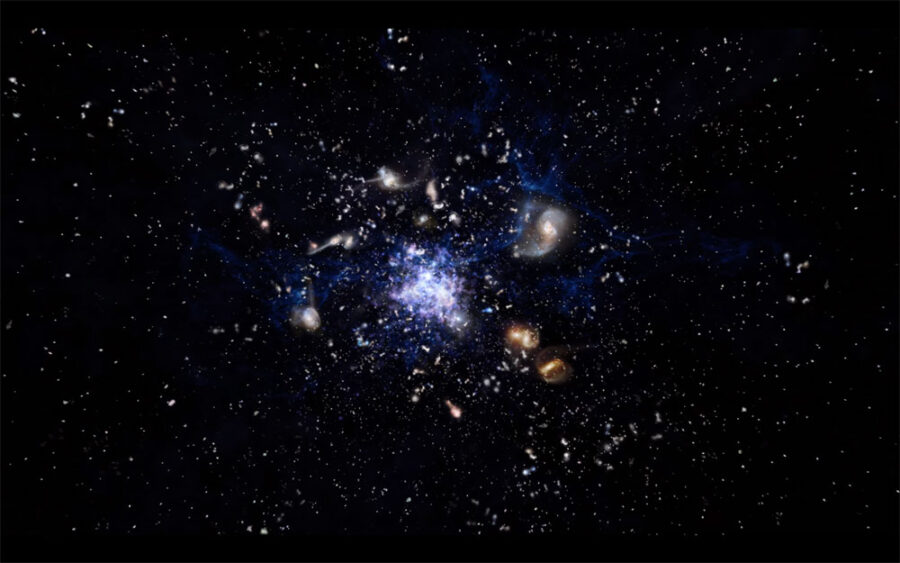Astronomers have discovered a cluster of galaxies coming together just 770 million years after the Big Bang.

ESO / M. Kornmesser
The gradual formation of giant galaxy clusters was well underway when the universe was 770 million years old, only 5.5% of its present age. In this early era — and correspondingly extreme distance —astronomers have discovered an elongated protocluster, consisting of two smaller systems of galaxies that will probably merge into one.
According to the discovery team, the find provides a unique natural laboratory to investigate the reionization process of the early universe. “It’s a neat and beautiful result,” comments Huub Röttgering (Leiden Observatory, The Netherlands).
Today’s galaxy clusters contain hundreds of individual members. However, they started out billions of years ago as mild overdensities in the distribution of galaxies. LAGER-z7OD1, as the newly discovered protocluster is called, contains 21 galaxies in an area of just 26.4 by 12 arcminutes. They’re all roughly the same distance from Earth, and they’re packed together five times as tightly as is typical of galaxies at similar distances. The discovery was published on January 25 in Nature Astronomy.
Weida Hu (University of Science and Technology of China) and his co-workers found the protocluster in data from the Dark Energy Camera on the 4-meter Blanco Telescope at the Cerro Tololo Inter-American Observatory in Chile. Using a narrowband near-infrared filter, they singled out young galaxies by their ionized hydrogen, which makes a spectral line known as Lyman-alpha. This ultraviolet wavelength redshifts to longer wavelengths as it passes through the expanding universe, so that it's in the near-infrared band by the time astronomers see it.
Spectroscopic measurements with the twin 6.5-meter Magellan telescopes at Las Campanas confirmed the extreme distance (corresponding to a redshift of 6.93) for 16 galaxies. Hu and his colleagues expect LAGER-z7OD1 to evolve into a massive cluster measuring about 100 million light-years across and with almost twice the mass of the nearby Coma cluster.
Astronomers think luminous young galaxies like these are the main source of radiation that (re-)ionized neutral hydrogen gas throughout the early universe. At 770 million years after the Big Bang, this reionization process must have been largely complete. Indeed, Hu and his collaborators expect that the bubbles of ionized gas surrounding each individual galaxy in LAGER-z7OD1 must be in the process of merging into one giant bubble surrounding the cluster. (Incidentally, LAGER stands for Lyman-Alpha Galaxies in the Epoch of Reionization.)
Looking back even earlier, astronomers would see galaxies’ Lyman-alpha emission redshifted all the way into the mid-infrared range, beyond the reach of ground-based telescopes. That’s where space-based telescopes come in. “The James Webb Space Telescope should be able to detect galaxies out to redshifts of 15,” says Röttgering, “and may discover early protoclusters at redshifts of 10 to 13.” The telescope, due to launch later this year, will provide astronomers with more information on the sources of the ionizing radiation in the early universe.
Meanwhile, radio observations by instruments like LOFAR (Low-Frequency Array) in Europe and the future low-frequency part of the Square Kilometre Array in Australia will reveal the distribution of the ionized gas bubbles on the sky and their growth with time. Röttgering says, “Ten years from now, we will have a much better understanding of the Epoch of Reionization.”
 0
0









Comments
You must be logged in to post a comment.